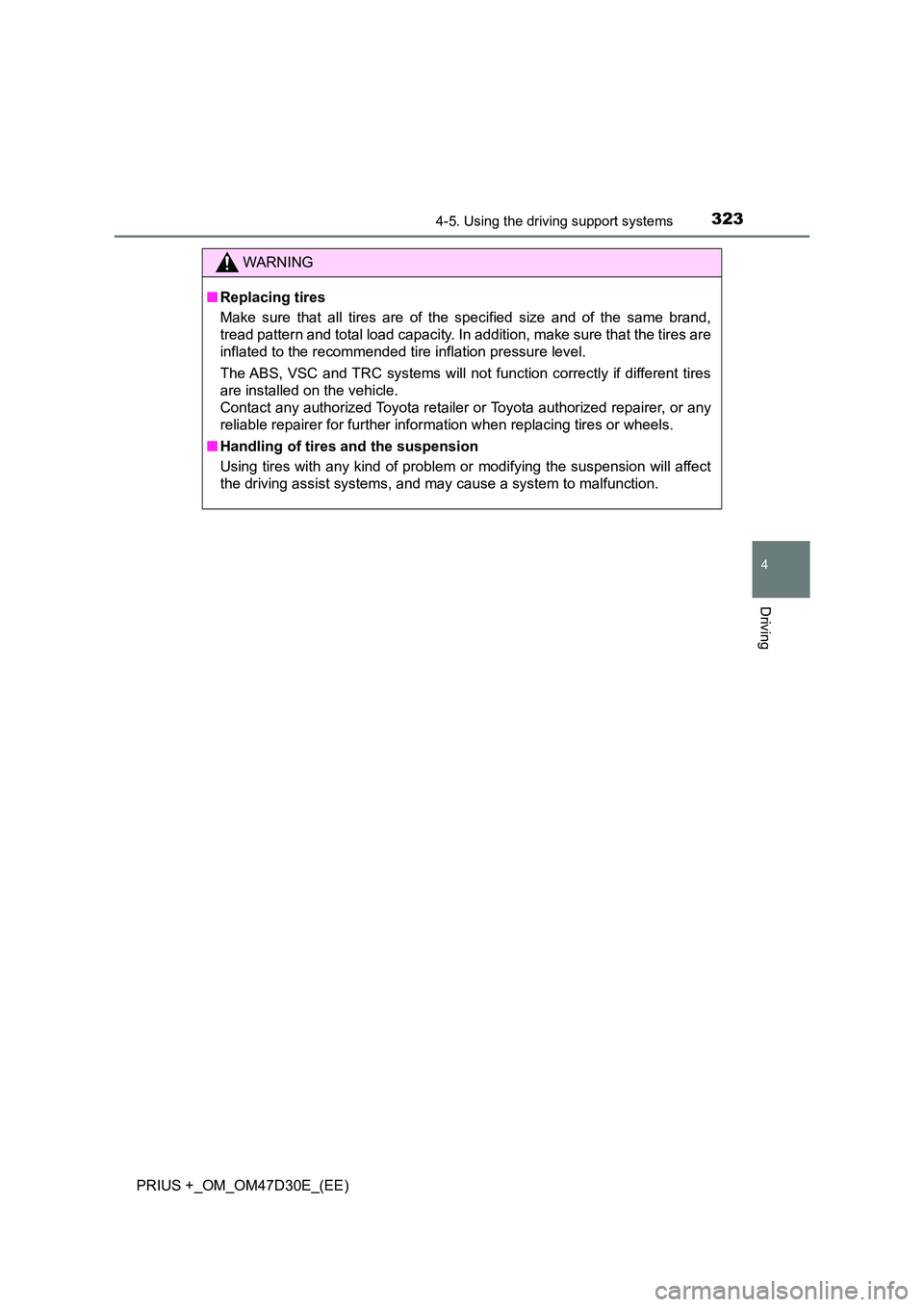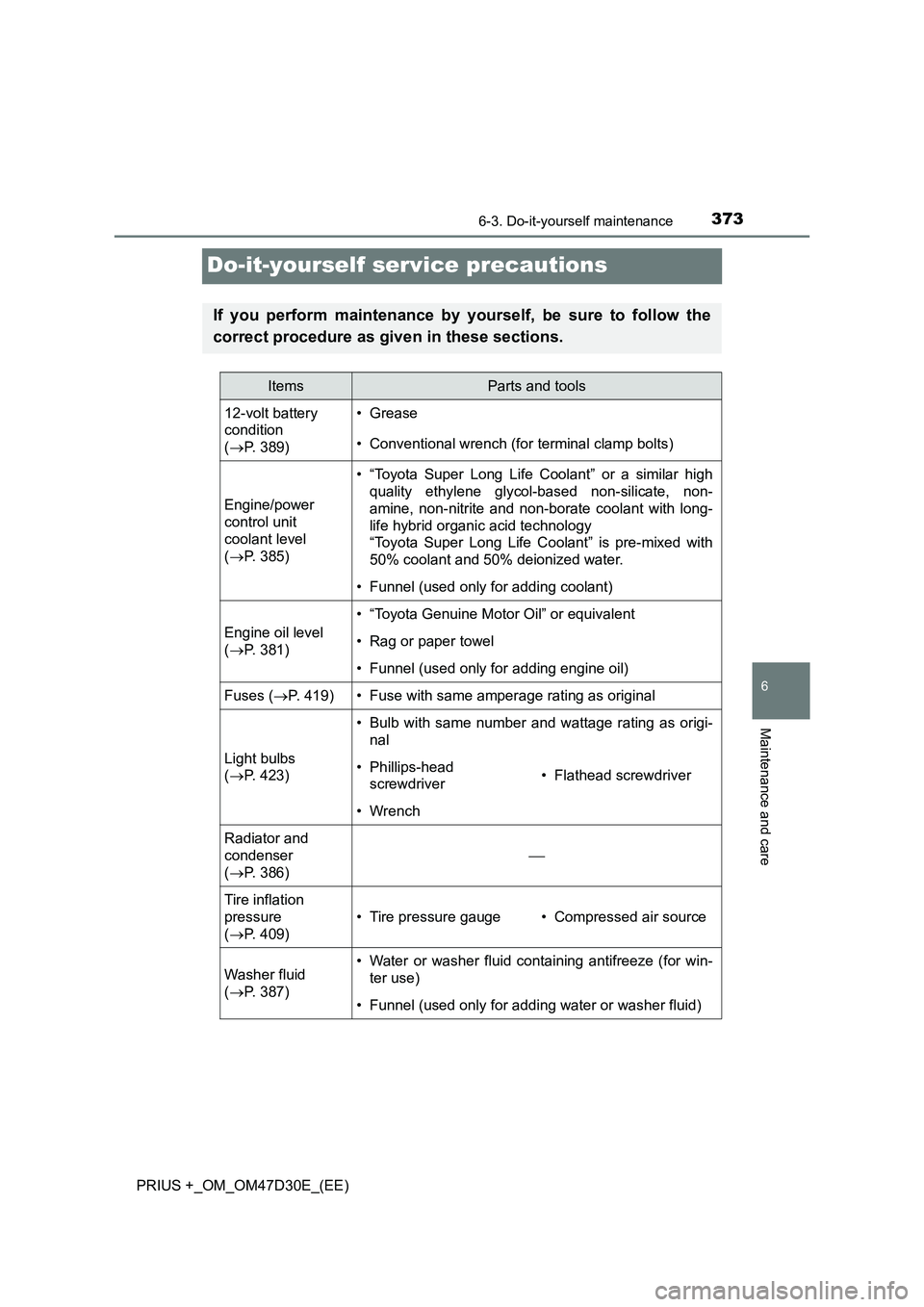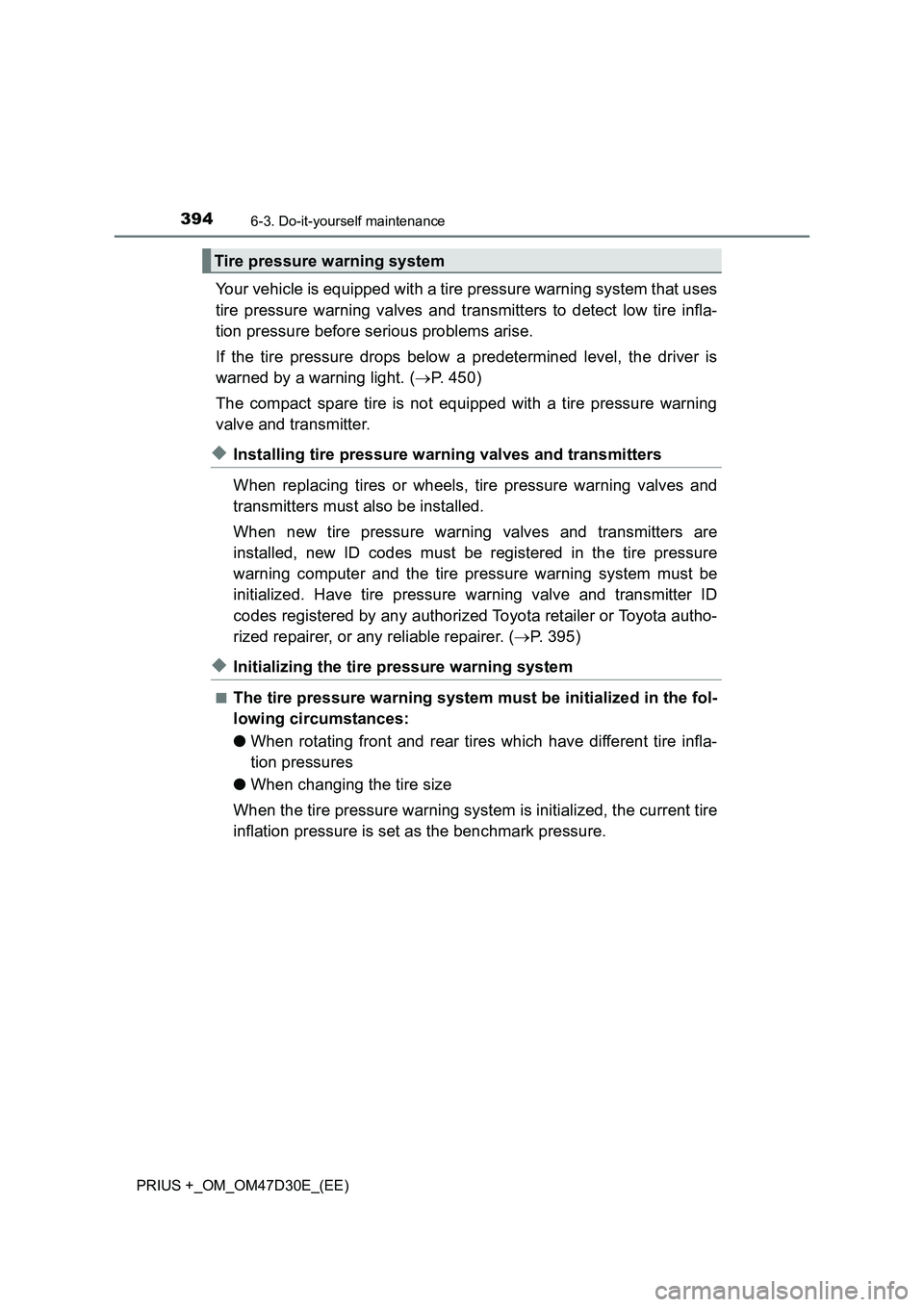2019 TOYOTA PRIUS PLUS inflation pressure
[x] Cancel search: inflation pressurePage 5 of 568

5
1
8
7
6
5
4
3
2
PRIUS +_OM_OM47D30E_(EE)
6-3. Do-it-yourself maintenance
Do-it-yourself service
precautions ......................373
Hood ..................................375
Positioning a floor jack .......377
Engine compartment..........379
12-volt battery ....................389
Tires ...................................393
Tire inflation pressure ........409
Wheels ...............................411
Air conditioning filter ..........413
Wiper rubber
replacement .....................415
Electronic key battery ........417
Checking and replacing
fuses ................................419
Light bulbs .........................423
7-1. Essential information
Emergency flashers ...........434
If your vehicle has to
be stopped in an
emergency .......................435
If the vehicle is trapped in
rising water ......................436
7-2. Steps to take in an
emergency
If your vehicle needs
to be towed ..................... 437
If you think something is
wrong .............................. 443
If a warning light turns on
or a warning buzzer
sounds ............................ 444
If a warning message is
displayed ......................... 458
If you have a flat tire
(vehicles with spare
tire) .................................. 478
If you have a flat tire
(vehicles without spare
tire) .................................. 492
If the hybrid system will
not start ........................... 509
If the electronic key does
not operate properly ........ 511
If the 12-volt battery is
discharged ...................... 513
If your vehicle
overheats ........................ 518
If the vehicle becomes
stuck................................ 523
7When trouble arises
Page 15 of 568

15Pictorial index
PRIUS +_OM_OM47D30E_(EE)Windshield wipers . . . . . . . . . . . . . . . . . . . . . . . . . . . . . . . . . P. 251
Precautions against winter season . . . . . . . . . . . . . . . . . . . . . P. 327
Precautions against car wash . . . . . . . . . . . . . . . . . . . . . . . . . P. 364
Fuel filler door . . . . . . . . . . . . . . . . . . . . . . . . . . . . . . . . . . . . P. 256
Refueling method . . . . . . . . . . . . . . . . . . . . . . . . . . . . . . . . . . P. 256
Fuel type/fuel tank capacity . . . . . . . . . . . . . . . . . . . . . . . . . . . P. 528
Tires . . . . . . . . . . . . . . . . . . . . . . . . . . . . . . . . . . . . . . . . . . . . P. 393
Tire size/inflation pressure . . . . . . . . . . . . . . . . . . . . . . . . . . . . P. 535
Winter tires/tire chain . . . . . . . . . . . . . . . . . . . . . . . . . . . . . . . . P. 327
Checking/rotation/tire pressure warning system . . . . . . . . . . . P. 393
Coping with flat tires . . . . . . . . . . . . . . . . . . . . . . . . . . . . P. 478, 492
Hood . . . . . . . . . . . . . . . . . . . . . . . . . . . . . . . . . . . . . . . . . . . . P. 375
Opening . . . . . . . . . . . . . . . . . . . . . . . . . . . . . . . . . . . . . . . . . . P. 375
Engine compartment cover . . . . . . . . . . . . . . . . . . . . . . . . . . . P. 380
Engine oil . . . . . . . . . . . . . . . . . . . . . . . . . . . . . . . . . . . . . . . . . P. 529
Coping with overheat . . . . . . . . . . . . . . . . . . . . . . . . . . . . . . . . P. 518
Headlights/front position lights/
daytime running lights . . . . . . . . . . . . . . . . . . . . . . . . . . . . . P. 241
Front fog lights/rear fog light
*. . . . . . . . . . . . . . . . . . . . . . . P. 250
Turn signal lights . . . . . . . . . . . . . . . . . . . . . . . . . . . . . . . . . . P. 239
Tail lights . . . . . . . . . . . . . . . . . . . . . . . . . . . . . . . . . . . . . . . . P. 241
License plate lights . . . . . . . . . . . . . . . . . . . . . . . . . . . . . . . . P. 241
Back-up light
*
Shifting the shift lever to R. . . . . . . . . . . . . . . . . . . . . . . . . . . . P. 233
4
5
6
7
Light bulbs of the exterior lights for driving
(Replacing method: P. 423, Watts: P. 536)
*: They may be located on the opposite side depending on the target region.
8
9
10
11
12
13
Page 281 of 568

2814-5. Using the driving support systems
4
Driving
PRIUS +_OM_OM47D30E_(EE)• When driving in inclement weather such as heavy rain, fog, snow or a
sandstorm
• When the vehicle is hit by water, snow, dust, etc. from a vehicle ahead
• When driving through steam or smoke
• When driving in a place where the surrounding brightness changes sud-
denly, such as at the entrance or exit of a tunnel
• When a very bright light, such as the sun or the headlights of oncoming
traffic, shines directly into the camera sensor
• When the surrounding area is dim, such as at dawn or dusk, or while at
night or in a tunnel
• After the hybrid system has started the vehicle has not been driven for a
certain amount of time
• While making a left/right turn and for a few seconds after making a left/
right turn
• While driving on a curve and for a few seconds after driving on a curve
• If your vehicle is skidding
• If the wheels are misaligned
• If a wiper blade is blocking the camera sensor
• The vehicle is wobbling.
• The vehicle is being driven at extremely high speeds.
• When driving on a hill
• If the radar sensor or camera sensor is misaligned
●In some situations such as the following, sufficient braking force may not be
obtained, preventing the system from performing properly:
• If the braking functions cannot operate to their full extent, such as when
the brake parts are extremely cold, extremely hot, or wet
• If the vehicle is not properly maintained (brakes or tires are excessively
worn, improper tire inflation pressure, etc.)
• When the vehicle is being driven on a gravel road or other slippery sur-
face • If the front of the vehicle is raised or
lowered
Page 323 of 568

3234-5. Using the driving support systems
4
Driving
PRIUS +_OM_OM47D30E_(EE)
WARNING
■Replacing tires
Make sure that all tires are of the specified size and of the same brand,
tread pattern and total load capacity. In addition, make sure that the tires are
inflated to the recommended tire inflation pressure level.
The ABS, VSC and TRC systems will not function correctly if different tires
are installed on the vehicle.
Contact any authorized Toyota retailer or Toyota authorized repairer, or any
reliable repairer for further information when replacing tires or wheels.
■ Handling of tires and the suspension
Using tires with any kind of problem or modifying the suspension will affect
the driving assist systems, and may cause a system to malfunction.
Page 326 of 568

3264-6. Driving tips
PRIUS +_OM_OM47D30E_(EE)
◆Checking tire inflation pressure
Make sure to check the tire inflation pressure frequently. Improper
tire inflation pressure can cause poor fuel economy.
Also, as snow tires can cause large amounts of friction, their use on
dry roads can lead to poor fuel economy. Use tires that are appro-
priate for the season.
◆Luggage
Carrying heavy luggage will lead to poor fuel economy. Avoid carry-
ing unnecessary luggage. Installing a large roof rack will also cause
poor fuel economy.
◆Warming up before driving
Since the gasoline engine starts up and cuts out automatically
when cold, warming up the engine is unnecessary. Moreover, fre-
quently driving short distances will cause the engine to repeatedly
warm up, which can lead to excess fuel consumption.
Page 361 of 568

361
6Maintenance and care
PRIUS +_OM_OM47D30E_(EE)6-1. Maintenance and care
Cleaning and protecting
the vehicle exterior .......... 362
Cleaning and protecting
the vehicle interior ........... 367
6-2. Maintenance
Maintenance
requirements.................... 370
6-3. Do-it-yourself maintenance
Do-it-yourself service
precautions ...................... 373
Hood .................................. 375
Positioning a floor jack ....... 377
Engine compartment.......... 379
12-volt battery .................... 389
Tires ................................... 393
Tire inflation pressure ........ 409
Wheels ............................... 411
Air conditioning filter .......... 413
Wiper rubber
replacement ..................... 415
Electronic key battery ........ 417
Checking and replacing
fuses ................................ 419
Light bulbs ......................... 423
Page 373 of 568

3736-3. Do-it-yourself maintenance
PRIUS +_OM_OM47D30E_(EE)
6
Maintenance and care
Do-it-yourself service precautions
If you perform maintenance by yourself, be sure to follow the
correct procedure as given in these sections.
ItemsParts and tools
12-volt battery
condition
(P. 389)• Grease
• Conventional wrench (for terminal clamp bolts)
Engine/power
control unit
coolant level
(P. 385)• “Toyota Super Long Life Coolant” or a similar high
quality ethylene glycol-based non-silicate, non-
amine, non-nitrite and non-borate coolant with long-
life hybrid organic acid technology
“Toyota Super Long Life Coolant” is pre-mixed with
50% coolant and 50% deionized water.
• Funnel (used only for adding coolant)
Engine oil level
(P. 381)
• “Toyota Genuine Motor Oil” or equivalent
• Rag or paper towel
• Funnel (used only for adding engine oil)
Fuses (P. 4 1 9 )• Fuse with same amperage rating as original
Light bulbs
(P. 423)
• Bulb with same number and wattage rating as origi-
nal
• Phillips-head
screwdriver• Flathead screwdriver
• Wrench
Radiator and
condenser
(P. 386)
Tire inflation
pressure
(P. 409)
• Tire pressure gauge• Compressed air source
Washer fluid
(P. 387)• Water or washer fluid containing antifreeze (for win-
ter use)
• Funnel (used only for adding water or washer fluid)
Page 394 of 568

3946-3. Do-it-yourself maintenance
PRIUS +_OM_OM47D30E_(EE)
Your vehicle is equipped with a tire pressure warning system that uses
tire pressure warning valves and transmitters to detect low tire infla-
tion pressure before serious problems arise.
If the tire pressure drops below a predetermined level, the driver is
warned by a warning light. (P. 450)
The compact spare tire is not equipped with a tire pressure warning
valve and transmitter.
◆Installing tire pressure warning valves and transmitters
When replacing tires or wheels, tire pressure warning valves and
transmitters must also be installed.
When new tire pressure warning valves and transmitters are
installed, new ID codes must be registered in the tire pressure
warning computer and the tire pressure warning system must be
initialized. Have tire pressure warning valve and transmitter ID
codes registered by any authorized Toyota retailer or Toyota autho-
rized repairer, or any reliable repairer. (P. 395)
◆Initializing the tire pressure warning system
■The tire pressure warning system must be initialized in the fol-
lowing circumstances:
●When rotating front and rear tires which have different tire infla-
tion pressures
●When changing the tire size
When the tire pressure warning system is initialized, the current tire
inflation pressure is set as the benchmark pressure.
Tire pressure warning system